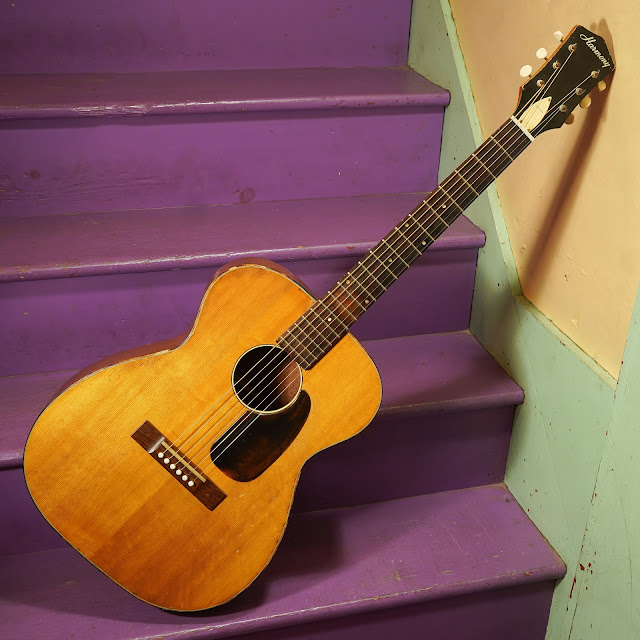1970 Harmony H162 000-Size Guitar
Not too long ago in years, I remember people busting-down my door in search of H165 and H162 models. They're neat guitars but I was always surprised that people were so enamored of them. They are, really, fairly basic guitars. I suppose a lot of them have wound-up in x-brace conversion land, though, judging by how many conversions of these guys are on the used market.
Still, I think the basic ladder-braced version is cooler in its thunky, woody, chunky-sounding way. They make good fingerpickers once they're fixed-up but you have to like the quirky character of them to make them a habit. They have medium-C necks with "shoulders" that are a little fatter than your average Gibson or Martin from the same era, so they feel a bit more like a '40s or '50s guitar to play.
I'd originally fixed this up earlier this week for a friend of mine to take home but after playing it for a bit he decided it was not his cup of tea despite enjoying the tone a lot. Considering his moving towards necks with a modern slim taper and close to 1 5/8" nut widths, though, I was not surprised at all! It's not a big neck but it's certainly not modern.
Repairs included: a neck reset, truss rod replacement (broken rod swapped for a non-adjustable carbon fiber rod), fret level/dress, new compensated bone saddle, binding replacement/repair, added side dots, cleaning, setup...
Top wood: solid spruce
Back & sides wood: solid mahogany
Bracing type: ladder
Bridge: rosewood
Fretboard: rosewood
Neck wood: poplar
Action height at 12th fret: 3/32” bass 1/16” treble (fast, spot-on)
String gauges: 52w, 40w, 30w, 22w, 16, 12 custom lights
Neck shape: medium C with fatter shoulders
Board radius: 10"
Truss rod: non-adjustable
Neck relief: straight (board had tiny twist so leveled/dressed difference out of frets)
Fret style: medium-lower
Scale length: 25 1/8"
Nut width: 1 3/4"
Body width: 15"
Body depth: 3 3/4"
Weight: 3 lbs 12 oz
Condition notes: ...so let's see! The major stuff is that the binding has deteriorated/outgassed/started to crumble and crack here and there. I saturated all the remaining bits with superglue and then replaced missing sections with black binding. There's one small section (1-2") on the back that has simply been replaced with fill, however, as nothing but thin viscosity super glue would stick to that area. Oh, celluloid rot!
What else? The saddle is replaced and I added side dots but the rest is original equipment. The original truss rod was broken, though, so I replaced it with a big, non-adjustable carbon fiber rod. This lightens the instrument a bit and is at least as stiff and effective as a traditional rod or Martin-style T-rod. In addition, compared to the average Harmony H162 neck, I will remark that every single note on the neck sounds a ton more even and clear now than it did with the murky-sounding wire rod. Stiffer necks = better sound.
And... what else? Well, of course it's all beat-up. You can see that in its myriad scratches and playwear. On the sides, there are a couple of hairline cracks -- one longer 6-8" one on the treble side that was repaired before my time (not the best repair but it's stable -- and someone sprayed flecked gold spray paint in that area too, just for fun). The other is a shorter hairline on the other side that's tight and repaired.
It comes with: no case, sorry.






















Comments